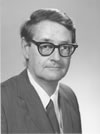About
In Memoriam: William R. Hunter,
Feb 04, 2012
In Memoriam: William R. Hunter, 1924 - 2012

William R. Hunter, an OSA Fellow Emeritus and an internationally renowned physicist at the U.S. Naval Research Laboratory from 1952 to 1980, died on 4 February 2012 in Fairfax, Virginia, at the age of 87.
Hunter’s experimental research in optics was essential for the development of innovative rocket and satellite instrumentation that recorded the first high-resolution images and spectra of the sun in the extreme ultraviolet and far ultraviolet wavelength regions. His papers in scientific journals gained widespread respect, and he mentored a generation of scientists in the areas of thin films, diffraction gratings, and calibrations of spaceflight instruments using synchrotron radiation.
Hunter earned a Masters degree in physics from the University of Florida (1949) following service in the U.S. Navy during World War II. He served at the Navy Mine Countermeasures Station in Panama City, his birthplace, from 1951-1952.
In 1953, Hunter was hired by Dr. Richard Tousey to join the Rocket Spectroscopy Branch of the U.S. Naval Research Laboratory’s Optics Division (later the Atmosphere and Astrophysics Division and the Space Science Division). There he led the development of highly reflective coatings for the mirrors and gratings that were used to image and disperse the solar FUV radiation, and thin metal filters that were transmissive to the FUV radiation and blocked the bright visible light from the sun.
Solar research by the Rocket Spectroscopy Branch accelerated during and following the International Geophysical Year (1957-1958) with the launch of numerous sounding rocket payloads from the White Sands Missile Range in New Mexico. In 1959, Hunter and his team won the highest award from the Photographic Society of America, the Progress Medal, for recording the first high-resolution images of the entire sun recorded at a discrete FUV wavelength, called spectroheliograms. The goal of the research was to relate the patterns of emission in the solar chromosphere to events such as flares that were believed to cause disturbances in the earth’s upper atmosphere, including radio black-outs, magnetic storms and the Northern Lights.
Beginning in the mid-1960s, with the company Baush & Lomb, Hunter developed and evaluated large normal-incidence gratings having greatly reduced scattered light which enabled improved contrast in the recorded spectral images. With Luxell Corporation, he developed and evaluated thin aluminum filters with improved stability for surviving the vibrations of the Saturn V rocket launch of the Skylab spacestation which carried an NRL spectroheliograph. In order to accurately evaluate the gratings and filters, Hunter developed an Optical Grating Reflection Evaluator (OGRE) system and an improved light source that became known in the EUV community as the “Hunter lamp.”
Hunter retired from the Space Science Division in 1980, but he continued his work in optics as a defense contractor until 2008.
Hunter was the author of several chapters in standard reference books on the properties of thin films and optics in the EUV and FUV wavelegnth regions. An OSA member since 1960, he was elected to Fellowship in the Society in 1968. He served on the FiO Program Committee in 1966 and again in 1990, on the OSA Tellers Committee (1967), and on the Max Born Award Committee (1983).
An accomplished violist, for many years he played as a member of the Fairfax, Virginia, Symphony Orchestra and in a string quartet, and in 1994 he was awarded the Orchestra’s Outstanding Service Award. He enjoyed traveling and made numerous family trips to remote Cape Breton Island, Nova Scotia, home to his mother’s family.
Hunter is survived by his wife of 63 years, Dorothy, four children, seven grandchildren and eight great-grandchildren.
If you would like to make a memorial donation to the OSA Foundation in honor of William Ray Hunter, please visit www.osa-foundation.org/give.
This obituary was contributed by OSA Fellow John Seely.
